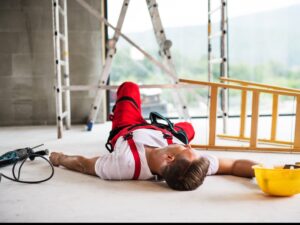This guide will explore when you could be eligible to make a fall at work claim. It will discuss the eligibility criteria that need to be met in order to seek personal injury compensation, the time limits for starting legal proceedings, and the evidence you can gather to build and strengthen your case.

What Do You Need To Do To Make A Fall At Work Claim?
Employer’s have a duty of care to their employees, and must adhere to the workplace health and safety legislation that outlines their responsibilities. We will discuss this in further detail throughout our guide, as well as how a breach of their duty could lead to an accident involving a fall at work, and the subsequent injuries you could be caused.
We will also look at the compensation that could be awarded for your injuries, and how payouts for a successful accident at work claim may be calculated.
Finally, we discuss No Win No Fee agreements, and how a solicitor offering their services under these terms could help.
If you’d like any further information, you can contact our team of advisors. They can offer free advice regarding your potential workplace injury claim and answer any questions you might have after reading. To reach them, you can:
- Contact us online
- Call using the number at the top of this page
- Use the live chat feature in the corner of this page
When Are You Eligible To Make A Fall At Work Claim?
You may be able to make a personal injury claim if you can prove that negligence occurred. The following three points lay the foundation of negligence in personal injury claims, and need to be met in order for you to be eligible to seek compensation for your injuries:
- Your employer owed you a duty of care at the time and location of the accident.
- There was a breach of this duty.
- You experienced harm as a result.
The Health and Safety at Work etc. Act 1974 sets the duty of care employers owe. It states that, in order to prevent harm to employees, they need to take steps considered both reasonable and practicable. A failure to do so could lead to a fall at work in which you sustain harm. For example:
- You fall from a faulty ladder that your employer instructed you to use while working on a construction site. As a result, you sustain a broken hand injury in a construction accident.
- You trip over trailing leads that haven’t been covered in an office. As a result, you fall and sustain a head injury in an office accident.
What Is The Accident At Work Claim Time Limit?
The standard accident at work time limit is three years from the date of the accident. As such, legal proceedings typically need to be started from this date as per The Limitation Act 1980. However, exceptions can apply.
If you would like to discuss when you could be eligible to make a fall at work claim, and how long you have to do so, please get in touch with an advisor on the number above.
Potential Evidence That Could Help You Make A Work Injury Claim
Evidence can strengthen a fall at work claim as it can demonstrate that employer negligence occurred. It can also offer insight into the injuries you sustained, and the impact they may have had on your life. As such, you may find it beneficial to gather the following:
- CCTV footage of the accident.
- A diary of any symptoms you experience, and treatment you have been given.
- Copies of any medical records produced after you seek medical attention, such as test results and scans.
- Photographs of your injury and the accident site.
- Contact details of any witnesses to your accident.
If you’re struggling to collect evidence, then providing you have a valid claim, a solicitor from our panel with experience handling accident at work claims could assist you. Should you wish to instruct a solicitor from our panel, please speak with an advisor. They can offer further information on the services you could be offered.
What Compensation Could You Receive From A Fall At Work Claim?
Accident at work settlements can comprise up to two heads of loss. Each compensates for the different ways in which your injuries have affected your life. General damages compensate for the pain and suffering caused by your injuries, both physical and mental.
Solicitors can use the guideline award brackets from the Judicial College Guidelines, alongside medical evidence, to help them value your injuries. We have included an excerpt of this document in the table below. However, you should only use these as a guide because they are not an exact representation of what you will receive following a successful claim.
| Injury | Severity | Compensation | Notes |
|---|---|---|---|
| Brain Damage | Very Severe | £282,010 to £403,990 | The person needs full-time nursing care. |
| Brain Damage | Moderately Severe | £219,070 to £282,010 | A very serious disability that is either cognitive or physical. The person will need constant care. |
| Leg Injury | Amputation (i) | £240,790 to £282,010 | Both legs are lost. |
| Back Injury | Severe (i) | £91,090 to £160,980 | Damage to the spinal cord and nerve roots. |
| Back Injury | Moderate (i) | £27,760 to £38,780 | A prolapsed intervertebral disc that requires surgery. |
| Hand Injury | Serious Damage | £55,820 to £84,570 | Significant function loss and permanent cosmetic disability. |
| Neck Injury | Moderate (i) | £24,990 to £38,490 | Serious soft tissue injuries that affect both the neck and the back together. |
| Neck Injury | Moderate (ii) | £13,740 to £24,990 | A severe disc lesion resulting in cervical spondylosis. |
| Wrist Injury | Less Severe | £12,590 to £24,500 | There is still some permanent disability, such as a degree of stiffness and pain that is ongoing. |
| Ankle Injury | Modest | Up to £13,740 | Less serious sprains and ligamentous injuries are included in this bracket. |
You can also receive compensation for the financial losses incurred as a result of your injuries under special damages as part of your overall payout. Examples of the costs you could claim back include:
- Cost of care
- Loss of earnings
- Cost of medication
- Cost of renovations to a home in aid of recovery.
Evidence of these losses should be gathered, including travel tickets, receipts, payslips and invoices.
For further guidance on the compensation you could receive following a successful fall at work claim, call our advisors using the number above.
Make A No Win No Fee Claim For An Accident At Work Using A Solicitor
If you have valid grounds to make a fall at work claim, and you wish to seek legal representation, you may benefit from working with an accident at work solicitor from our panel.
They can offer their services under No Win No Fee terms. As such, they may represent your claim under a Conditional Fee Agreement. Usually under the terms of this agreement, you can avoid having to pay any fees for the work your solicitor does upfront, as your claim proceeds, or if the case has an unsuccessful outcome.
Following the completion of a successful case, your solicitor will take a percentage of your compensation. This is capped by the law, however, ensuring you keep the majority of your compensation.
Contact Us For Free
If you require any further information about making a fall at work claim, please contact an advisor. They can also offer a free case check to determine if you have valid grounds to seek compensation for your injuries. If you do, you could be connected with a solicitor from our panel.
To reach them, you can:
- Contact us online
- Call using the number at the top of this page
- Use the live chat feature in the corner of this page
Learn More About How To Make A Workplace Accident Claim
For more of our helpful guides:
- Find out about claiming for a fracture at work.
- Learn how much compensation you could receive for an arm injury at work.
- Read our guide to learn when you could claim for a neck injury at work.
For more external resources:
- GOV – Statutory Sick Pay
- NHS – First Aid
- Health and Safety Executive – Working At A Height
Thank you for reading this guide on when you could make a fall at work claim. If you have any other questions, please call an advisor on the number above.
Writer Louis Peach
Editor Meg Martin

